1996 PONTIAC BONNEVILLE height
[x] Cancel search: heightPage 18 of 387
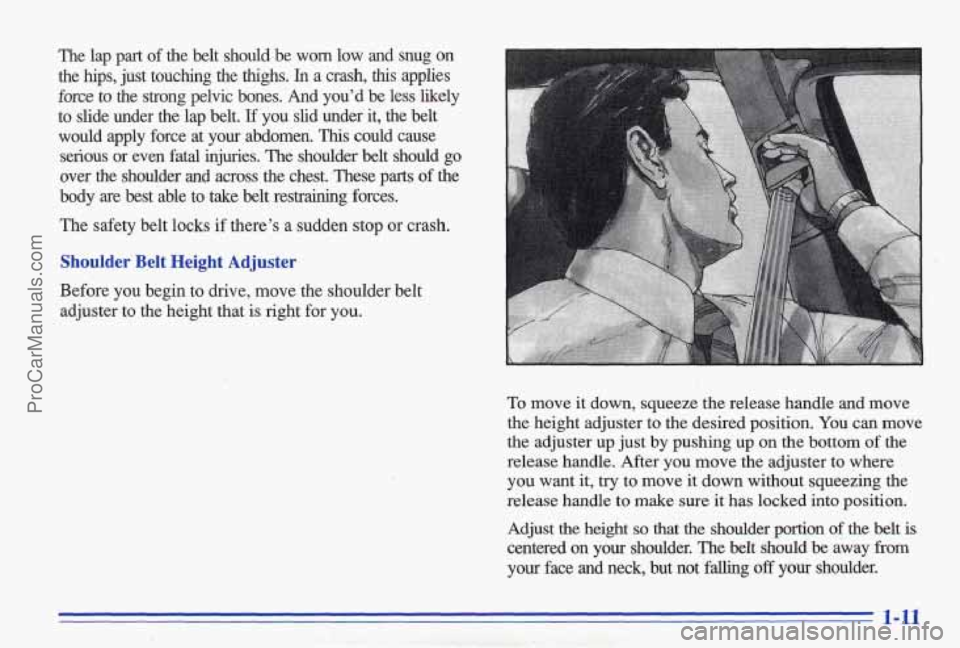
The lap part of the belt should be worn low and snug on
the hips, just touching the thighs. In a crash, this applies
force to the strong pelvic bones. And you'd be less likely
to slide under the lap belt.
If you slid under it, the belt
would apply force at your abdomen.
This could cause
serious or even fatal injuries. The shoulder belt should go
over the shoulder and across the chest. These parts of the
body are best able to take belt restraining forces.
The safety belt locks
if there's a sudden stop or crash.
Shoulder Belt Height Adjuster
Before you begin to drive, move the shoulder belt
adjuster to the height that is right for you.
To move it down, squeeze the release handle and move
the height adjuster to the desired position. You
can move
the adjuster
up just by pushing up on the bottom of the
release handle. After you move the adjuster to where you want it,
try to move it down without squeezing the
release handle
to make sure it has locked into position.
Adjust the height
so that the shoulder portion of the belt is
centered on your shoulder. The belt should be away fkom
your face and neck, but not falling off your shailder.
1-11
ProCarManuals.com
Page 129 of 387
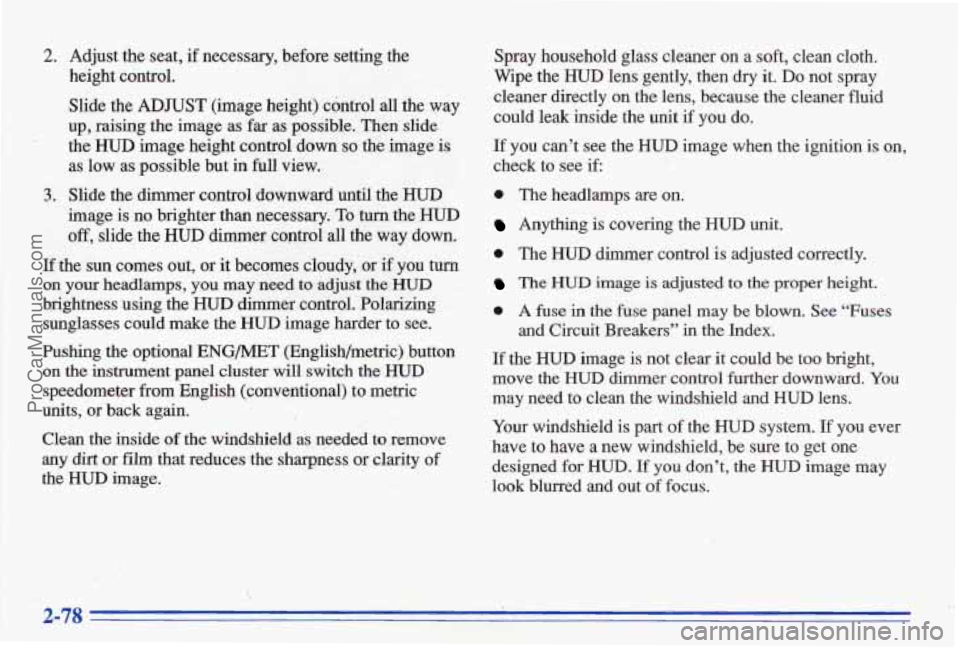
2. Adjust the seat, if necessary, b’efore setting the
height control.
Slide the
ADJUST (image height) cimtrol all the way
up,
raising the image as far ,as possible. Then slide
the HUD image height control down so the image is
as low as possible but in full view.
image
is no brighter than necessary. To turn the HUD
off, slide the HUB dimmer coptrol all the way down.
If the sun comes out, or it becomes cloudy, ur if you turn
on your headlamps, you may need to adjust them
brightness using the HUD ciirrmer co&ol. Polarizing
sunglasses could make
the HUD image harder to see.
Pushing $he uptional ENG/MET (English/metric) button
on the instrument panel cluster will switch the HUD
speedometer from English (conventional) to metric
units, or back again.
Clean the inside
of the windshield as needed to remove
any dirt or film -that reducesthe sharpness CJT clarity of
the HUD image.
3. Slide the dimmer control downward until the HUD
Spray household glass cleaner on a soft, clean cloth.
Wipe the
HUD lens gently, then dry it. Do not spray
cleaner directly on the lens, because the cleaner
fluid
could leak inside the unit if you do.
If you can’t see the HUD image when the ignition is on,
check
to see if:
0 The headlamps are on.
Anything is covering the HUD unit.
0 The HUD dimmer control is adjusted correctly.
The HUD image is adjusted to the proper height.
0 A fuse in the fuse panel may be blown. See “Fuses
and Circuit Breakas” in the Index.
If the F€WR image is not clear it could be too bright,
move the HUD dimmer control further downward. You
may need to clean the windshield and HUD lens.
Your windshield is part of the
HUD system. If you ever
have
to have a new windshield, be sure to get one
designed for WUD. If you don’t, the HUD image may
look blurred and out
of focus.
ProCarManuals.com
Page 276 of 387
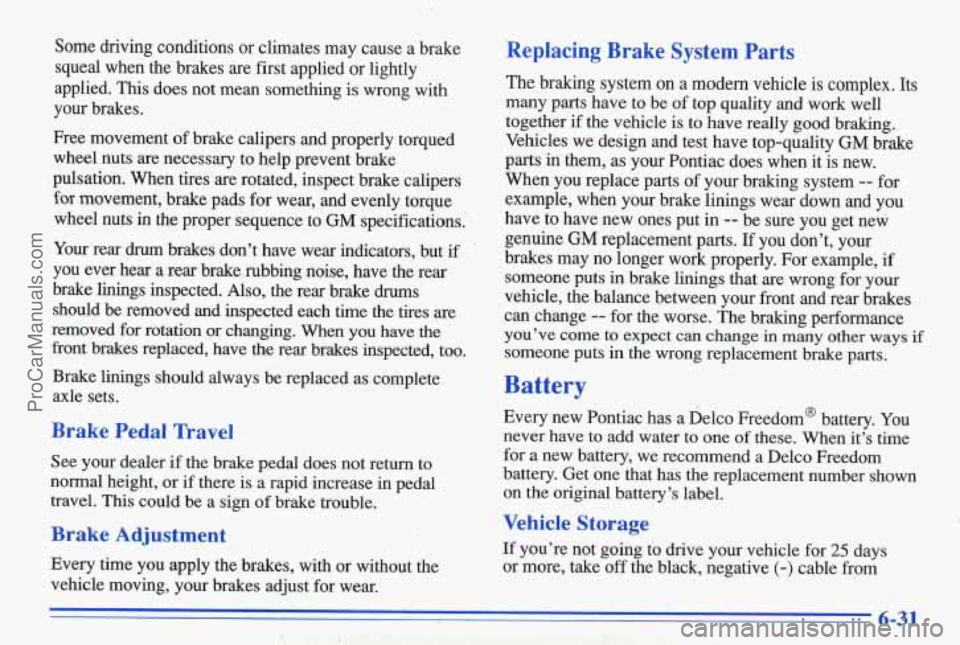
Some driving conditions or climates may cause a brake squeal when the brakes are first applied or lightly
applied. This does not mean something is wrong with
your brakes.
Free movement of brake calipers and properly torqued
wheel nuts are necessary to help prevent brake
pulsation. When tires are rotated, inspect brake calipers
for movement, brake pads for wear, and evenly torque
wheel nuts in the proper sequence to
GM specifications.
Your rear drum brakes don’t have wear indicators, but
if
you ever hear a rear brake, rubbing noise, have the rear
brake
linings inspected. Also, the rear brake drums
should be removed and inspected each time the tires are
removed for rotation or changing.
When you have the
front brakes replaced, have the rear brakes inspected,
too.
Brake linings should always be replaced as complete
axle sets.
Brake Pedal Travel
See your dealer if the brake pedal does not return to
normal height,
or if there is a rapid increase in pedal
travel.
This could be a sign of brake trouble.
Brake Adjustment
Every time you apply the brakes, with or without the
vehicle moving, your brakes adjust for wear.
Replacing Brake System Parts
The braking system on a modern vehicle is complex. Its
many parts have to be of top quality and work well
together
if the vehicle is to have really good braking.
Vehicles we design and test have top-quality GM brake
parts in them, as your Pontiac does when it is.new.
When you replace parts of your braking system
-- for
example, when your brake linings wear down and you
have to have new ones put in
-- be sure you get new
genuine GM replacement parts.
If you don’t, your
brakes may no longer work properly. For example, if someone puts in brake linings that are wrong for your
vehicle, the balance between your front and rear brakes can change
-- for the worse. The braking performance
you’ve come to expect can change
in many other ways if
someone puts in the wrong replacement brake parts.
Battery
Every new Pontiac has a Delco Freedom@ battery. You
never have to add water to one
of these. When it’s time
for
a new battery, we recommend a Delco Freedom
battery. Get one that has the replacement number shown on the
original battery’s label. : 1
Vehicle Storage . ..
If you’re not going to drive your vehicle for 25 days
or more, take
off the black, negative (-) cable from
..I
6-31
ProCarManuals.com
Page 293 of 387
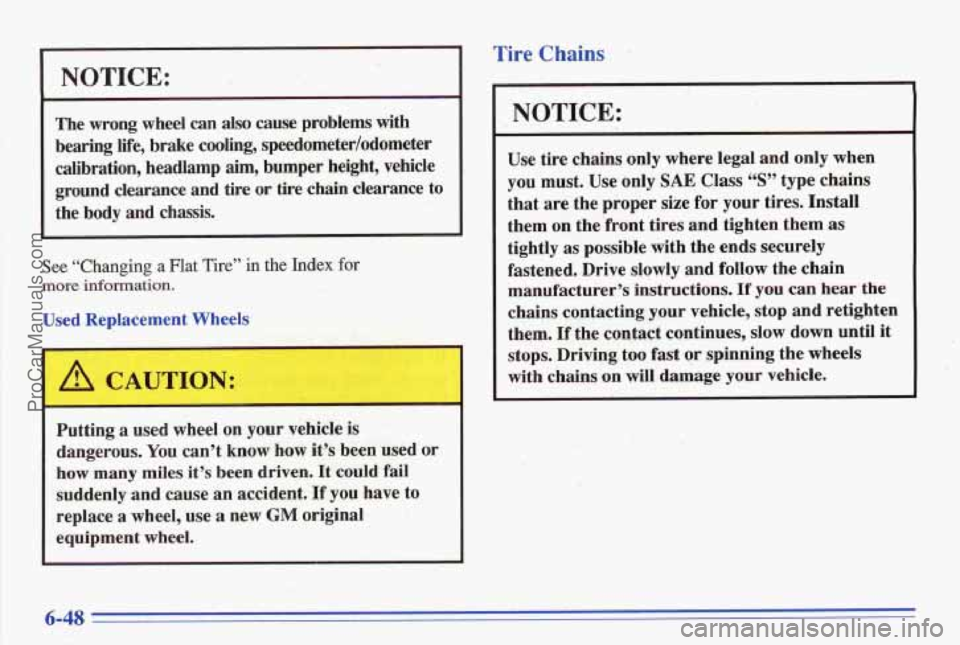
NOTICE:
The wrong wheel can also cause problems with
bearing life, brake cooling, speedometer/odometer
calibration, headlamp aim, bumper height, vehicle
ground clearance and tire or tire chain clearance to
the body and chassis.
.. -* ‘ .. ’ see “Changing a Flat Tire” in the Index for
‘more information.
.. .‘I, . .I .
.‘. -- . 8; . Putting a used wheel on your vehicle is
;. .. . dangerous. You can’t know how it’s been used or
,.; how many miles it’s been driven. It could fail
-. :% suddenly and cause an accident. If you have to
. -1 . .. I -.~ I., .<.
.. ?1 :: :. <.. >. - ., 3
I .) .
,,.. ‘,,‘t, . .?. I
.: replace a wheel, use a new GM original
.I , . ..
., , equipment wheel. -.
-. ., ..
I
Tire Chains
NOTICE:
Use tire chains only where legal and only when
you must. Use only
SAE Class 44S” type chains
that are the proper size for
your tires. Install
them on the front tires and tighten them as
tightly as possible with the ends securely
fastened. Drive slowly and follow the chain
manufacturer’s instructions.
If you can hear the
chains contacting
your vehicle, stop and retighten
them.
If the contact continues, slow down until it
stops. Driving too fast or spinning the wheels
with chains on will damage your vehicle.
* “
ProCarManuals.com
Page 311 of 387

~ Air Conditioning Refrigerants'
I, 1 .c , ;Not all air conditioning refrigerants are the same.
If the air conditioning system in your vehicle needs
refrigerant, be sure the proper refrigerant is used.
If you're not sure, ask your Pontiac dealer.
Engine Specifications
VIN Engine Code ........................... K
Displacement ......................... 3.8 Liters
Horsepower
.......................... ,205-hp
3800 Series 11 Engine (L36)
Qpe ..................................... V6
Firing Order ........... I ........... 1-6-5-4-3-2
Thermostat Temperature
........... 195°F (91°C)
3800 Supercharged Engine (L67)
VIN Engine Code .......... '. ................ 1
Type .................................... V6
Displacement ........................ 3.8 Liters
Horsepower
.......................... .240-hp
Firing Order ...................... 1-6-5-4-3-2
Thermostat Temperature
.... ; ...... 195°F (91°C)
Normal Maintenance
Replacement Parts'
Air Cleaner Filter ............. AC Type A- 1096C
Engine
Oil Filter ................ AC Type PF-47
Transaxle Filter
............ GM Part No. 8651909
Sparkplugs
......... ; .......... AC Type 41-921
Gap:
0.060 inch (1.52 mm)
Vehicle Dimensions
Wheelbase ............ 110.8 inches (2 814.3 mm)
Tread Width
Front
................ 60.4 inches (1 534.2 mm)
Length .............. 201.9 inches (5 124.0 mm)
Width ................. 74.6 inches (1 893.2 mm)
Height ................. 55.7 inches (1 414.8 mm)
Rear ........... i ...... 60.3 inches (1 531.6 mm)
ProCarManuals.com
Page 382 of 387
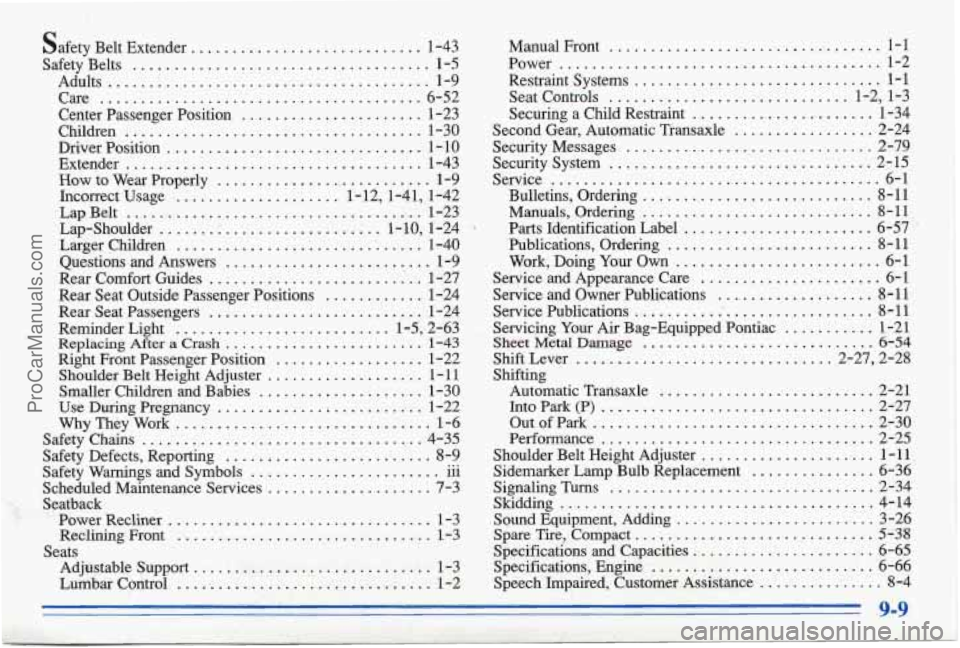
safety Belt Extender ....... ....... 1-43
Safety Belts
.................................... 1-5
Adults
....................................... 1-9
Care
....................................... 6-52
Center Passenger Position
...................... 1-23
Children
................. ............ 1-30
Driver Position ............................... 1 . 10
Extender
.................................... 1-43
How to Wear Properly .......................... 1-9
Incorrect Usage
.................... 1.12.1.41. 1.42
LapBelt
.................................... 1-23
Lap-Shoulder
....... : ................... 1.10. 1.24 .
Larger Children .............................. 1-40
Questions and Answers
......................... 1-9
Rear
Comfort Guides ............. .. ............. 1-27
Rear Seat Outside Passenger Positions
............ 1-24
Rear Seat Passengers
.......................... 1-24
Reminder Light
.......................... 1.5. 2.63
Replacing After a Crash ........................ 1-43
Right Front Passenger Position .................. 1-22
Smaller Children and Babies
.................... 1-30
Use
During Pregnancy ......................... 1-22
Why They Work ........................... ., ... 1-6
Safety Chains
................................... 4-35
Safety Defects. Reporting ......................... 8-9
Safety Warnings and Symbols
....................... 111
Seatback .Shoulder Belt Height Adjuster
................... 1 . 11
...
...... , ... ,,Scheduled Maintenance Services .................... 7-3
.... . Power Recliner ................................ 1-3
: . Reclining Front ............................... 1-3
".Seats
Adjustable Support
.............................. 1-3
Lumbar Control
............................... 1-2
...
..
Manual Front . . ... ......... 1-1
Power ..................... ....... 1-2
Restraint Systems
.............................. 1-1
Seat Controls ............................. 1-2, 1-3
Securing a Child Restraint
...................... 1-34
Second Gear. Automatic Transaxle
................. 2-24
Security Messages
............................. -2-79
SecuritySystem ................................ 2-15
Service
........................................ 6-1
Bulletins, Ordering
............................ 8-11
Manuals, Ordering
............................ 8-11
Parts Identification Label ....................... 6-57
Publications, Ordering
......................... 8-11
Work,
Doing Your Own ......................... 6-1
Service and Appearance Care
...................... 6-1
Service and Owner Publications
.................... 8-11
Service Publications
............................... 8-11
Servicing Your Air Bag-Equipped Pontiac ........... 1-21
Sheet Metal Damage ............................ 6-54
Shift Lever ............................... 2-27, 2-28
Shifting
Automatic Trarisaxle
.......................... 2-21
Into
Park (P) ................................. 2-27
Out of Park .................................. 2-30
Performance
................................. 2-25
Shoulder Belt Height Adjuster ...................... 1-11
Sidemarker Lamp Bulb Replacement ............... 6-36
Signaling
Turns ................................ 2-34
Sound Equipment, Adding ......................... 3-26
Spare Tire? Compact
............................. 5-38
Specificahom and Capacities ...................... 4-65
Specifications, Engine ........................... 6-66
Speech Impaired, Cusimner Assistance
............... 8-4
Skidding
...................................... 4-14
ProCarManuals.com